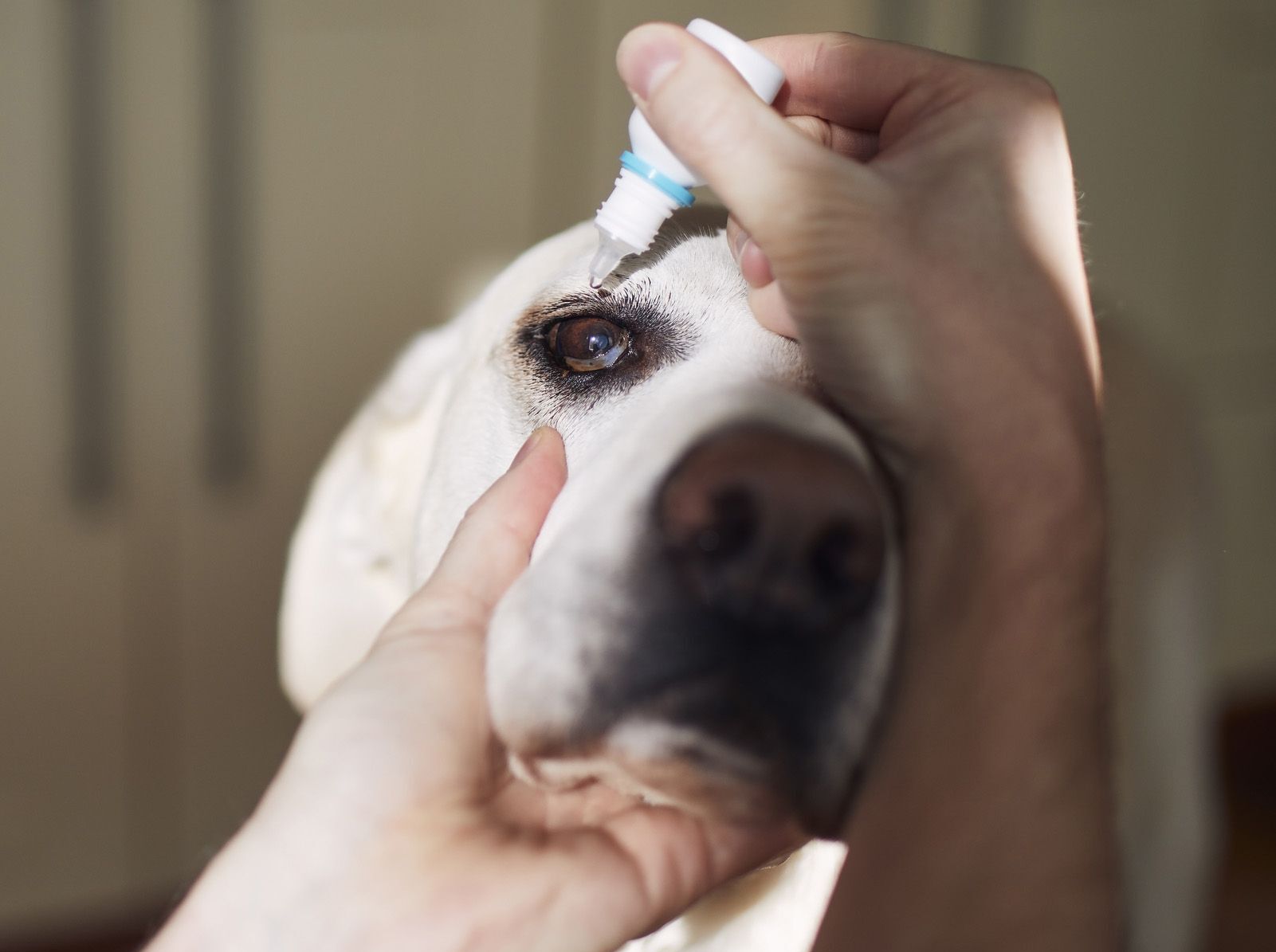Home>Health & Wellness>Nutrition & Diet>How Long Should You Wait For Your Dog To Eat Prescription Diet If She Doesn’t Like It


Nutrition & Diet
How Long Should You Wait For Your Dog To Eat Prescription Diet If She Doesn’t Like It
Published: January 28, 2024
Learn how to handle a dog's reluctance to eat prescription diet and ensure proper nutrition and diet for your pet.
(Many of the links in this article redirect to a specific reviewed product. Your purchase of these products through affiliate links helps to generate commission for Pawsomeoldies.com, at no extra cost. Learn more)
Table of Contents
Introduction
Introducing a prescription diet to your dog can be a challenging endeavor, especially if your furry friend is hesitant to embrace the new dietary regimen. As a responsible pet owner, it's natural to feel concerned when your dog displays reluctance or aversion towards the prescribed food. However, it's important to approach this situation with patience, understanding, and a proactive mindset.
Transitioning your dog to a prescription diet is often necessary to address specific health concerns or dietary requirements. Whether it's managing a chronic condition, supporting weight management, or addressing food sensitivities, prescription diets are meticulously formulated to cater to your dog's unique needs. While the transition may present initial hurdles, it's crucial to prioritize your dog's well-being and adhere to the dietary recommendations provided by your veterinarian.
Understanding the reasons behind your dog's resistance to the prescription diet is essential for devising effective strategies to encourage acceptance. Factors such as taste preferences, texture, ingredient unfamiliarity, and even behavioral associations can influence your dog's initial response to the new food. By recognizing these potential challenges, you can approach the transition process with empathy and a proactive mindset.
In this comprehensive guide, we will delve into the intricacies of introducing a prescription diet to your dog and address common concerns pet owners may encounter. By exploring the factors affecting your dog's acceptance of the prescribed food, offering practical tips to encourage a smooth transition, and providing insights on the appropriate timeline for adjustment, this guide aims to empower pet owners with the knowledge and confidence to support their dog's dietary transition effectively. Let's embark on this journey to ensure the well-being and nutritional health of your beloved canine companion.
Understanding the Importance of Prescription Diet for Dogs
Prescription diets play a pivotal role in addressing a myriad of health concerns and nutritional requirements specific to dogs. These specialized diets are meticulously formulated to cater to various conditions such as obesity, diabetes, kidney disease, gastrointestinal disorders, food sensitivities, and joint health, among others. Unlike standard commercial pet foods, prescription diets are designed to provide targeted nutrition that supports the management and treatment of specific health issues.
One of the key aspects of prescription diets is their ability to address dietary sensitivities and allergies. Dogs with food sensitivities or allergies may exhibit symptoms such as skin irritation, gastrointestinal distress, and chronic ear infections. Prescription diets are crafted to exclude common allergens and incorporate hypoallergenic ingredients, thereby minimizing the risk of triggering adverse reactions and promoting overall well-being.
Moreover, prescription diets are instrumental in managing chronic conditions such as kidney disease. These specialized formulations are adept at controlling key nutritional components such as protein, phosphorus, and sodium, which are crucial for supporting kidney function and mitigating the progression of the disease. Similarly, prescription diets tailored for diabetic dogs are designed to regulate blood sugar levels and facilitate weight management, thereby contributing to the overall management of the condition.
In cases of obesity, prescription diets are formulated to facilitate weight loss through controlled calorie intake and enhanced satiety. These diets prioritize lean protein sources, fiber-rich ingredients, and precise nutrient ratios to support healthy weight reduction while ensuring optimal nutrient intake. Additionally, prescription diets for joint health incorporate ingredients such as omega-3 fatty acids, glucosamine, and chondroitin to alleviate joint discomfort and promote mobility in dogs with arthritis or musculoskeletal issues.
By recognizing the diverse health benefits of prescription diets, pet owners can appreciate the crucial role these specialized formulations play in supporting their dog's overall well-being. The tailored nutritional profiles, precise ingredient selection, and therapeutic properties of prescription diets underscore their significance in managing specific health conditions and optimizing the nutritional health of dogs. As pet owners navigate the process of introducing a prescription diet to their canine companions, understanding the profound impact of these specialized formulations is essential for fostering a proactive and informed approach to their dog's dietary requirements.
Factors Affecting Your Dog's Acceptance of Prescription Diet
The acceptance of a prescription diet by your dog can be influenced by a multitude of factors, each playing a significant role in shaping your dog's response to the new dietary regimen. Understanding these factors is crucial for devising effective strategies to encourage acceptance and facilitate a smooth transition. Here are key elements that can impact your dog's acceptance of a prescription diet:
Taste Preferences:
Dogs, like humans, have distinct taste preferences. The flavor profile of the prescription diet may differ from the familiar commercial food your dog is accustomed to. This variation in taste can initially deter your dog from embracing the new diet. Factors such as the intensity of flavors, aroma, and texture can influence your dog's perception of the food, potentially leading to initial reluctance.
Texture and Consistency:
The texture and consistency of the prescription diet play a pivotal role in your dog's acceptance. Dogs may exhibit preferences for specific textures, such as crunchy kibble, tender morsels, or a certain level of moisture content. The deviation from the familiar texture of their previous food can impact their initial response to the prescription diet.
Read more: How Long Should A Dog Be On A Bland Diet
Ingredient Unfamiliarity:
Prescription diets often feature specialized ingredients tailored to address specific health concerns. The introduction of novel ingredients, flavors, or nutrient compositions may be met with hesitation by your dog. Ingredient familiarity can significantly influence your dog's willingness to consume the new diet, especially if they have developed strong preferences for certain ingredients.
Behavioral Associations:
Dogs form behavioral associations with their feeding routines and environments. Changes in feeding schedules, mealtime locations, or the introduction of a new food can disrupt these established associations, leading to initial resistance. Behavioral factors, such as stress, anxiety, or environmental changes, can also impact your dog's receptiveness to the prescription diet.
Previous Feeding Practices:
The transition to a prescription diet may involve a shift from free-feeding to scheduled meals or vice versa. Dogs accustomed to specific feeding practices may exhibit resistance to changes in their mealtime routines. Additionally, previous feeding practices, such as table scraps or treats, can influence your dog's acceptance of the prescribed food.
By recognizing these influential factors, pet owners can approach the transition to a prescription diet with empathy and a proactive mindset. Understanding your dog's individual preferences, behavioral patterns, and environmental influences is essential for implementing effective strategies to encourage acceptance and facilitate a seamless dietary transition.
Tips for Encouraging Your Dog to Eat Prescription Diet
-
Gradual Transition: Introduce the prescription diet gradually by mixing it with your dog's current food. Start with a small proportion of the new diet and gradually increase the ratio over several days. This gradual transition can help acclimate your dog to the new flavors and textures without overwhelming their palate.
-
Enhance Palatability: To enhance the palatability of the prescription diet, consider warming it slightly or adding a small amount of low-sodium broth. These simple modifications can elevate the aroma and appeal of the food, making it more enticing for your dog.
-
Interactive Feeding: Engage your dog in interactive feeding activities, such as food puzzles or slow-feeders. These enrichment tools not only stimulate mental engagement but also create a positive association with the new diet, encouraging your dog to approach mealtime with enthusiasm.
-
Avoid Free-Feeding: Establish a consistent feeding schedule to regulate meal times and prevent free-feeding. This structured approach can encourage your dog to develop a routine and a healthy appetite for the prescribed food.
-
Minimize Distractions: Create a calm and distraction-free environment during meal times. Minimizing external stimuli and disturbances can help your dog focus on the food, promoting a more positive and uninterrupted eating experience.
-
Positive Reinforcement: Utilize positive reinforcement techniques by offering verbal praise, gentle petting, or small, healthy treats when your dog shows interest in the prescription diet. This positive association can reinforce the acceptance of the new food.
-
Consult with Your Veterinarian: Seek guidance from your veterinarian to explore potential flavor alternatives within the prescribed diet range. Your veterinarian can provide valuable insights and recommend alternative formulations that align with your dog's preferences.
-
Patience and Consistency: Approach the transition with patience and consistency. It's natural for dogs to exhibit initial hesitation towards new foods. Consistently offering the prescription diet while maintaining a patient and supportive demeanor can facilitate a gradual acceptance over time.
By implementing these practical tips, pet owners can navigate the process of encouraging their dogs to embrace the prescription diet with empathy and strategic approaches. Each dog is unique, and understanding their individual preferences and behavioral cues is essential for tailoring effective strategies that promote a smooth and successful transition to the prescribed food.
Read more: How Long Should A Dog Be On A Rice Diet
How Long to Wait for Your Dog to Eat Prescription Diet
The timeline for your dog to fully embrace a prescription diet can vary significantly based on individual preferences, behavioral patterns, and the effectiveness of the transition strategies employed. It's important to approach this aspect of the dietary transition with patience, understanding that dogs may require varying durations to adjust to the new food. While there isn't a definitive timeframe that universally applies to all dogs, observing your pet's response and implementing proactive measures can contribute to a successful transition.
In the initial stages of introducing the prescription diet, it's common for dogs to display hesitation or reluctance towards the unfamiliar food. This initial phase of adjustment can range from a few days to several weeks, depending on your dog's receptiveness and the transition approach. It's essential to monitor your dog's eating behavior, demeanor, and overall well-being during this period, as these observations can provide valuable insights into their progress.
As you navigate the transition process, it's crucial to remain consistent in offering the prescription diet while implementing the recommended strategies to encourage acceptance. Consistency plays a pivotal role in acclimating your dog to the new food, and it's normal for dogs to exhibit gradual progress over time. By maintaining a patient and supportive approach, pet owners can create a conducive environment for their dogs to adjust at their own pace.
While some dogs may readily embrace the prescription diet within a relatively short timeframe, others may require an extended period of gradual adjustment. Factors such as taste preferences, texture familiarity, and previous feeding practices can influence the duration of the transition. It's important to acknowledge and respect the individuality of each dog's response, allowing them the necessary time to adapt to the new dietary regimen.
Throughout the transition period, it's beneficial to engage with your veterinarian and seek their guidance if your dog continues to display resistance or reluctance towards the prescribed food. Your veterinarian can offer tailored recommendations, potential adjustments to the transition approach, or alternative formulations within the prescribed diet range to address your dog's specific needs.
Ultimately, the duration for your dog to fully embrace the prescription diet is a dynamic and individualized process. By prioritizing patience, consistency, and proactive support, pet owners can navigate this transition with empathy and a proactive mindset, fostering a positive and successful adjustment to the prescribed food.
When to Seek Veterinary Advice
Seeking veterinary advice is paramount when navigating the transition to a prescription diet for your dog. While the majority of dogs may gradually acclimate to the new food with patience and strategic approaches, there are instances where professional guidance becomes essential. Understanding the circumstances that warrant veterinary consultation empowers pet owners to proactively address potential challenges and ensure the well-being of their canine companions.
Prolonged Refusal or Disinterest:
If your dog consistently displays prolonged refusal or disinterest in the prescription diet despite diligent efforts to encourage acceptance, it's advisable to seek veterinary advice. Persistent reluctance towards the new food over an extended period may indicate underlying concerns that require professional assessment. Your veterinarian can conduct a comprehensive evaluation to identify potential factors contributing to your dog's resistance and recommend tailored solutions.
Significant Changes in Eating Behavior:
Observing significant changes in your dog's eating behavior, such as a sudden loss of appetite, aversion to food, or unusual feeding patterns, necessitates prompt veterinary attention. These shifts in eating behavior can signal underlying health issues, dental discomfort, gastrointestinal disturbances, or emotional stress that may impact your dog's willingness to consume the prescribed diet. Consulting with your veterinarian enables timely intervention and targeted management of potential health concerns.
Unexplained Gastrointestinal Distress:
If your dog experiences unexplained gastrointestinal distress, such as persistent vomiting, diarrhea, or abdominal discomfort following the introduction of the prescription diet, veterinary consultation is imperative. These symptoms may indicate adverse reactions, digestive sensitivities, or dietary intolerance that require professional assessment. Your veterinarian can conduct diagnostic evaluations, recommend alternative formulations, or adjust the transition approach to alleviate gastrointestinal distress and ensure your dog's nutritional well-being.
Weight Loss or Nutritional Concerns:
Noticing unexplained weight loss, nutritional deficiencies, or inadequate nutrient intake during the transition to the prescription diet warrants veterinary attention. These indicators may signify challenges in adapting to the new food, underlying health conditions, or inadequate dietary support. Your veterinarian can conduct nutritional assessments, address potential health implications, and recommend tailored strategies to optimize your dog's nutritional intake and overall well-being.
Persistent Behavioral Stress or Anxiety:
If your dog exhibits persistent behavioral stress, anxiety, or emotional distress associated with meal times and the introduction of the prescription diet, seeking veterinary advice is crucial. Behavioral factors can significantly impact your dog's acceptance of the new food, and professional guidance can facilitate the implementation of behavioral management strategies and supportive interventions to alleviate stress and promote positive mealtime experiences.
By recognizing the pivotal scenarios that warrant veterinary consultation, pet owners can prioritize their dog's health and well-being throughout the transition to a prescription diet. Proactively seeking veterinary advice empowers pet owners to address potential challenges effectively, optimize the transition process, and ensure that their canine companions receive the necessary support and care tailored to their individual needs.
Conclusion
In conclusion, the process of introducing a prescription diet to your dog encompasses a journey marked by patience, understanding, and proactive engagement. The transition to a specialized dietary regimen is underpinned by the profound significance of prescription diets in addressing specific health concerns, nutritional requirements, and overall well-being. Understanding the multifaceted factors that influence your dog's acceptance of the prescribed food, coupled with practical strategies to encourage a smooth transition, empowers pet owners to navigate this process with empathy and informed decision-making.
The acceptance of a prescription diet by your dog is influenced by a myriad of factors, including taste preferences, texture familiarity, ingredient unfamiliarity, behavioral associations, and previous feeding practices. Recognizing these influential elements enables pet owners to tailor their approach, implement effective strategies, and create a conducive environment that fosters acceptance and gradual adjustment to the new food.
By embracing practical tips such as gradual transition, enhancing palatability, interactive feeding, and positive reinforcement, pet owners can actively support their dogs through the transition process. It's essential to approach this journey with patience, consistency, and a keen awareness of your dog's individual preferences and behavioral cues. While the timeline for your dog to fully embrace the prescription diet may vary, maintaining a supportive and proactive approach is instrumental in facilitating a successful transition.
Furthermore, the importance of seeking veterinary advice in specific scenarios, such as prolonged refusal or disinterest, significant changes in eating behavior, unexplained gastrointestinal distress, weight loss or nutritional concerns, and persistent behavioral stress or anxiety, underscores the proactive and attentive approach necessary to ensure your dog's well-being throughout the transition.
Ultimately, the transition to a prescription diet for your dog is a dynamic and individualized process that demands empathy, patience, and a proactive mindset. By prioritizing your dog's nutritional health, well-being, and unique preferences, pet owners can navigate this journey with confidence, informed decision-making, and a deep commitment to supporting their canine companions' overall wellness.












